1、复刊词CreateTime
Times常用词汇(艺术、商业、计算机、犯罪)
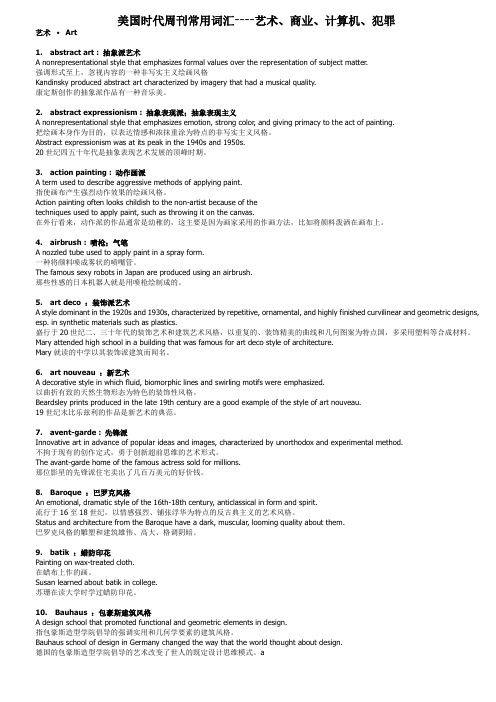
美国时代周刊常用词汇----艺术、商业、计算机、犯罪艺术·Art1. abstract art : 抽象派艺术A nonrepresentational style that emphasizes formal values over the representation of subject matter.强调形式至上,忽视内容的一种非写实主义绘画风格Kandinsky produced abstract art characterized by imagery that had a musical quality.康定斯创作的抽象派作品有一种音乐美。
2. abstract expressionism : 抽象表现派;抽象表现主义A nonrepresentational style that emphasizes emotion, strong color, and giving primacy to the act of painting.把绘画本身作为目的,以表达情感和浓抹重涂为特点的非写实主义风格。
Abstract expressionism was at its peak in the 1940s and 1950s.20世纪四五十年代是抽象表现艺术发展的顶峰时期。
3. action painting : 动作画派A term used to describe aggressive methods of applying paint.指使画布产生强烈动作效果的绘画风格。
Action painting often looks childish to the non-artist because of thetechniques used to apply paint, such as throwing it on the canvas.在外行看来,动作派的作品通常是幼稚的,这主要是因为画家采用的作画方法,比如将颜料泼洒在画布上。
国外期刊投稿、审稿过程以及常用术语

学习了一些杂志的在线投稿系统中的作者,审稿人,编辑部和总编的分工和作业情况,在这里和新手以某一个典型例子进行探讨学习一下。
1. Author 作者如何在线投稿?在线投稿大致步骤:Step 1: Log In 登陆The login page gives you three options:1. Log in with your known User ID and Password 用户名和密码2. Check to see if you have an existing account 确认是否已经注册过3. Create a new account 没有就注册一个Step 2: Enter your Author Center 进入作者中心To begin a new submission, check a previous submission, continue a submission begun earlier, or submit a revised manuscript, choose Author Center. 确认是新投,还是投修改稿Step 3: Inside Your Author Center 在个人的作者中心里面Existing manuscripts are found in one of three areas: 包括三个区域(这个每个杂志可能有区别的)Manuscripts to be Revised 需修改稿Partially Submitted Manuscripts 部分上传稿Submitted Manuscripts 已上传稿To start a NEW manuscript submission, choose “Submit First Draft of New Manuscript” link. 开始上传新稿Step 4: Entering Data 输入资料The following screens ask you to enter each piece of data associated with your manuscript. Most of this data will also be included in the text of your manuscript, but needs to be entered in this format in order to make the system searchable by these fields. It is used for screen display and e-mail notifications only. You cannot enter text into the Manuscript Data Summary table –scroll down each screen to enter the required information. 按照提示一步一步输入Press “Save and Continue” at the bottom of each screen in order to save all of your work. If you press the "Back" or "Forward" button on your browser your work will not be saved. 继续时选择保存和继续,如果点击back或者forward,原来输入的内容会消失。
科技论文英语翻译修辞
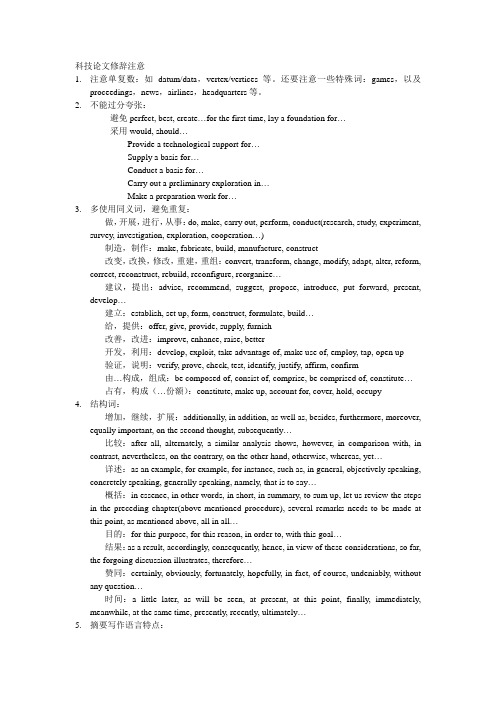
科技论文修辞注意1.注意单复数:如datum/data,vertex/vertices等。
还要注意一些特殊词:games,以及proceedings,news,airlines,headquarters等。
2.不能过分夸张:避免perfect, best, create…for the first time, lay a foundation for…采用would, should…Provide a technological support for…Supply a basis for…Conduct a basis for…Carry out a preliminary exploration in…Make a preparation work for…3.多使用同义词,避免重复:做,开展,进行,从事:do, make, carry out, perform, conduct(research, study, experiment, survey, investigation, exploration, cooperation…)制造,制作:make, fabricate, build, manufacture, construct改变,改换,修改,重建,重组:convert, transform, change, modify, adapt, alter, reform, correct, reconstruct, rebuild, reconfigure, reorganize…建议,提出:advise, recommend, suggest, propose, introduce, put forward, present, develop…建立:establish, set up, form, construct, formulate, build…给,提供:offer, give, provide, supply, furnish改善,改进:improve, enhance, raise, better开发,利用:develop, exploit, take advantage of, make use of, employ, tap, open up验证,说明:verify, prove, check, test, identify, justify, affirm, confirm由…构成,组成:be composed of, consist of, comprise, be comprised of, constitute…占有,构成(…份额):constitute, make up, account for, cover, hold, occupy4.结构词:增加,继续,扩展:additionally, in addition, as well as, besides, furthermore, moreover, equally important, on the second thought, subsequently…比较:after all, alternately, a similar analysis shows, however, in comparison with, in contrast, nevertheless, on the contrary, on the other hand, otherwise, whereas, yet…详述:as an example, for example, for instance, such as, in general, objectively speaking, concretely speaking, generally speaking, namely, that is to say…概括:in essence, in other words, in short, in summary, to sum up, let us review the steps in the preceding chapter(above-mentioned procedure), several remarks needs to be made at this point, as mentioned above, all in all…目的:for this purpose, for this reason, in order to, with this goal…结果:as a result, accordingly, consequently, hence, in view of these considerations, so far, the forgoing discussion illustrates, therefore…赞同:certainly, obviously, fortunately, hopefully, in fact, of course, undeniably, without any question…时间:a little later, as will be seen, at present, at this point, finally, immediately, meanwhile, at the same time, presently, recently, ultimately…5.摘要写作语言特点:a.破题主动句,介绍作者或论文观点与内容。
TPO高频必背词汇

TPO高频必背词汇词汇来源:全部选自OG和TPO里摘录的高频且必须掌握的词汇。
唯一要求:听到就能迅反应出意思或形象。
1、对话场景词汇:A:Office Hours—Student & Professor论文:office hour [ˈɔfis][ˈauə]n.办公时间term paper [tə:m][ˈpeipə]n.学期论文.the first draft [ðə] [fə:st][drɑ:ft]n.初稿look over a draft version [luk][ˈəuvə][ə][drɑ:ft][ˈvə:ʃən]v.检查草拟版本hand in the final copy[hænd][in][ðə] [ˈfainəl] [ˈk ɔpi]v.提交最后打印版scope [skəup]n.范围wander off topic [ˈwɔndə] [ɔ(:)f][ˈtɔpik]v.跑题. design plan [diˈzain] [plæn]n.设计方案.essay[ˈesei]n.作文,散文rewrite[ˌri:ˈrait]v.重写revise[riˈvaiz]v.校正comment[ˈkɔment]n.vt.评论reference section [ˈrefərəns] [ˈsekʃ(ə)n]n.参考部分考试专业疑难解答:assignment [əˈsainmənt]n.作业grade[greid]n.成绩credit[ˈkredit]n.学分mid-term exam [mid][tə:m] [igˈzæm]n.期中考试group project[gru:p] [ˈprɔdʒekt]n.团队项目due[dju:]adj.截止deadline [ˈdedlain]n.截止日期extension[ikˈstenʃən]n.延期选课:Preparatory Course [priˈpærətəri] [kɔ:s]n.预备课程:foundation course [faunˈdeiʃən] [kɔ:s]n.基础课程intro/introduction course[ˈɪntrəʊ]/ [ˌintrəˈdʌkʃən] [kɔ:s].n.导论课程intermediate Course[ˌintəˈmi:diət] [kɔ:s]n.中级课程advanced course [ədˈvɑ:nst] [kɔ:s]n.高级课程申请志愿者:volunteer[ˌvɔlənˈtiə]n.志愿者campus[ˈkæmpəs]n校园semester[siˈmestə]n.学期(半年)[英式term;术语] scholarship/fellowship[ˈskɔləʃip] [ˈfeləuʃip]n.奖学金迷路和其他:orientation[ˌɔ:riənˈteiʃən]n.大学新生介绍校园生活和学习retire [riˈtaiə]v.退休graduate [ˈgrædjueit]vi. 毕业n.毕业生B:Student & Officer 学生对工作人员(1)注册与咨询Registrar’s Off ice:注册办公室sign up [saɪn ʌp]v.注册,选课,报名course[kɔ:s]n.课程prerequisite[ˈpri:ˈrekwizit]n.预备知识,先决条件. permission[pəˈmiʃən]n.允许,许可mailing address[ˈmeiliŋ əˈdres]n.邮寄地址at the administration office[æt, ət] [ðə, ði:] [ədˌminisˈtreiʃən] [ˈɔfis]n.行政办公室graduation form[ˌgrædʒuˈeiʃən] [fɔ:m]n.毕业表格diploma[diˈpləumə]n.毕业证书.academic record[ˌækəˈdemik] [ˈrekɔ:d, riˈkɔ:d]n.学业成绩graduation requirements[ˌgrædʒuˈeiʃən] [riˈkwaiəmənts]要求department chair [diˈpɑ:tmənt][tʃɛə] /chairperson['t ʃɛəpə:sn]n.系主任dean [di:n]n.院长;系主任credit[ˈkredit]n.学分introductory course[ˌintəˈdʌktəri][kɔ:s]n.基础入门课程the intermediate level course[ðə, ði:] [ˌintəˈmi:diət] [ˈlevəl] [kɔ:s]n.中级水平basic course [ˈbeisik] [kɔ:s]n.基础课程foundational classe [faunˈdeiʃən] [ˈklæsik]基础课程field work [fild wɚk] /research [riˈsə:tʃ]n.实地研究verify [ˈverifai]vt.证实certify[ˈsə:tifai]vt.证明Counseling Center:咨询中心counselor[ˈkaunsələ]n.咨询员(2)图书馆与书店Library:图书馆librarian[laiˈbrɛəriən]n.图书管理员inter-library[ˈɪntə(r)][ˈlaibrəri]n.图书馆间loan[ləun]v.n.借loan counter[ləun][ˈkauntə] n.借书处loan period [ləun] [ˈpiəriəd] n.借书期限return[riˈtə:n]v.还renew[riˈnju:]v.更新,续reserve[riˈzə:v]vt.预留/n.储备photocopier[ˈfəʊtəʊkɔpɪə(r)]n.影印机fine[fain]vt.罚款/n.罚金literature review [ˈlitərətʃə][riˈvju:]n.文献评论electronic [iˌlekˈtrɔnik]adj.电子版的journal[ˈdʒə:nəl]n.期刊database [ˈdeitəbeis]n.数据库published and unpublished data [ˈpʌbliʃt][ənd][ˏʌnˋpʌblɪʃt] [ˈdeitə]n.数据title[ˈtaitl]n.标题screen[skri:n]n.电脑屏幕an abstract [ən, æn] [ˈæbstrækt]vt.摘要newspaper reviews[ˈnju:sˌpeipə] [riˈvju:z]n.报纸评论contemporary reviews[kənˈtempərəri] [riˈvju:z]n.当代评论in the basement[in] [ðə, ði:] [ˈbeismənt]n.地下室reference guide [ˈrefərəns] [gaid]n.参考指南the reference stacks[ðə, ði:] [ˈrefərəns] [stæks]n.书库video library [ˈvidiəu] [ˈlaibrəri]n.录像图书馆student orientation[ˈstju:dənt] [ˌɔ:riənˈteiʃən]n.情况介绍(针对大学新生)the front desk[ðə, ði:][frʌnt] [desk]n.前台charge[tʃɑ:dʒ] =fee[fi:]n.费用the rare books[ðə, ði:] [reə] [buks]珍藏本书gloves[glʌvz]手套Bookstore:书店full refund [ful] [riˈfʌnd, ˈri:fʌnd]n.退款retreat[riˈtri:t]n.退书merchandises[ˈmə:tʃəndaiz]n.商品purchased ['pə:tʃəst] =buy [bai] vt.买policy [ˈpɔləsi]n.规定store credit [stɔ:][ˈkredit] n.商店退款;赊账购物(3)实验室language lab manager:实验室video [ˈvidiəu]n.视频;录像(4)食堂Cafeteria:食堂restaurant ['restərɔnt] /dining room[ˈdaɪnɪŋ] [ru:m]n.餐厅organic food [ɔ:ˈgænik] [fu:d]n.有机食物deep fried food [di:p] [fraid] [fu:d]n.油炸食物waiter [ˈweitə] n.男服务员waitress[ˈweitris] n.女服务员snack[snæk]n.小吃,快餐salad[ˈsæləd]n.沙拉(5)打工与求职Department Secretary:部门秘书salary [ˈsæləri] =income[ˈinkʌm]n.工资paycheck ['peitʃek]n.薪水bank account[bæŋk əˈkaʊnt] n.银行存款/账户deposits[diˈpɔzits]n.存款payroll [ˈpeirəul]n.工资单;薪水册form[fɔ:m]n.表格table [ˈteibəl]n.表格chart[tʃɑ:t]n.图表cash[kæʃ]n.现金fax[fæks]n.传真bill [bil]n.账单credit card[ˈkrɛdɪt kɑrd]n.信用卡Career Services Office:就业服务办公室career [kəˈriə]n.职业recruit [riˈkru:t]vt.招聘interview [ˈintəvju:]n.面试resume [ˈrezju:mei]n.简历employee [imˈplɔi-i:] n.雇员employer [imˈplɔiə]n.雇主career [kəˈriə] /job fair[dʒɑb fɛr]n.招聘会website ['webˌsait]n.网站recommend letter [ˌrekəˈmend] [ˈletə]n.推荐信firm[fə:m] =company [ˈkʌmpəni] =corporation [ˌk ɔ:pəˈreiʃən]n.公司wear a suit [wɛə][ei, ə, æn, ən] [su:t, sju:t]n.正装advancement [ədˈvɑ:nsmənt]=promotion [prəˈməuʃən]n.晋升freshman [ˈfreʃmən]n.大一新生sophomore[ˈsɔfəmɔ:]n.大二junior[ˈdʒu:niə]n.大三seniors [ˈsi:niə]n.大四学生(6)社团与课外活动faculty advisor:指导老师dorm [dɔ:m] /dormitory [ˈdɔ:mitəri]n.宿舍social[ˈsəuʃəl]a.社交academics[ˌækəˈdemik]a.学术feedback [ˈfi:dbæk]n.反馈facilities manager:后勤经理chorus[ˈkɔ:rəs] =choir[ˈkwaiə]n.合唱队rehearsal [riˈhə:səl]n.排练,预演auditorium [ˌɔ:diˈtɔ:riəm]n.礼堂,会堂construction [kənˈstrʌkʃən]n.建筑施工hall [hɔ:l]n.大厅laboratory [ləˈbɔrətəri]n.实验室concert [ˈkɔnsət]n.音乐会reschedule [ri:ˈʃedju:l]vt.重新安排时间表Campus Activities. 校园活动announcement[əˈnaunsmənt]n.公告;通告summit[ˈsʌmit]n.提交request [riˈkwest] vt./n.请求poster [ˈpəustə]n.海报flyers [ˈflaiəz]n.传单Administrating Office行政办公楼gym card [dʒim] [kɑ:d]n.健身卡2、讲座学科词汇:讲座场景A-- Social Science 社会科学(1)考古学与人类学考古:Archaeologyhistorical relic[hisˈtɔrikəl] [ˈrelik]n.遗迹excavation [ˌekskəˈveiʃən]n.挖掘grave= tomb [greiv]=[tu:m]n.坟墓bury[ˈberi]v.埋葬primitive [ˈprimitiv]n.原始人,adj原始的the Neolithic period/age[ðə] [ˌni:əuˈliθik] [ˈpiəriəd]/[eidʒ]=New stone age[nju:] [stəun][eidʒ]n.新石器时代the Paleolithic period/age[ðə] [ˌpæliəuˈliθik] [ˈpiəriəd]/[eidʒ]= the Old/late Stone Age [ðə] [əuld]/ [leit] [stəun][eidʒ]n.旧石器时代shelter [ˈʃeltə] n.庇护所inhabit [inˈhæbit]vt.居住于religion[riˈlidʒən]n.宗教ceremony[ˈseriməni]n.仪式obsidian[ɔbˈsidiən]n.黑曜石pyramid[ˈpirəmid]n.金字塔人类学:AnthropologyNative American [ˈneitiv][əˈmerikən]n. 美洲原住民,印第安人the natural resources [ðə][ˈnætʃərəl] [riˈsɔ:sis]n.自然资源waterproof[ˈwɔ:təpru:f]=watertight[ˈwɔ:tətaitnis] adj.防水的cooking container [ˈkukiŋ] [kənˈteinə]n.容器utensil[ju:ˈtensəl]n.餐具,炊具bowl [bəul]n.碗canoe [kəˈnu:]独木舟alliance [əˈlaiəns]=federation[ˌfedəˈreiʃən]n.联盟(2)哲学与历史哲学:PhilosophyAncient Greek philosopher [ˈeinʃənt][gri:k] [fiˈlɔsəfə]n.古希腊哲学家希腊哲学三杰:Socrates[ˈsɔkrəti:z]苏格拉底;Plato[ˈpleitəu]柏拉图;Aristotle[ˈæristɔtl]亚里士多德Aristotle’s ethical theory[ˈæristɔtlz][ˈeθikəl] [ˈθiəri]n.伦理学happiness [ˈhæpinis]n.幸福历史:Historyancient Rome/Greek[ˈeinʃənt][rəum]/[gri:k]n.古罗马/希腊Europe [ˈjuərəp] n.欧洲Britain [ˈbritən]n.英国Italy [ˈitəli] n. 意大利Rome(Roma) [rəum] n.罗马Greek [gri:k] n.希腊Egypt[ˈi:dʒipt] n.埃及France [ˈfræns] n.法国Germany [ˈdʒə:məni] n.德国Spain [spein] n.西班牙Turkey[ˈtə:ki] n.土耳其(Turkish)Netherlands[ˈneðələndz] =Holland[ˈhɔlənd] n.荷兰(Dutch荷兰人)Canada [ˈkænədə] n.加拿大(Canadian [kəˈneidiən] n.加拿大人)(3)经济商业与政治经济学Economics商业Businessprosper[ˈprɔspə]vi.繁荣dotcom crash[ðə][dɒtˈkɒm][kræʃ]n.互联网泡沫out of business 歇业,破产.irrational [iˈræʃənəl]adj.不理性的boom and bust[bu:m] [ænd][bʌst] 繁荣与萧条industry [ˈindəstri]n.产业,工业native to [ˈneitiv][tu]原产至hail from [heil][frɔm]来自于,出产于remote mountainous region [riˈməut] [ˈmauntinəs] [ˈri:dʒən]n.偏远山区nomad [ˈnəumæd]n.游牧民merchant [ˈmə:tʃənt]n.商人diplomat [ˈdipləmæt]n.外交官tulip mania [ˈtju:lip][ˈmeiniə]n.狂热gardening=horticulture [ˈɡɑːdnɪŋ]=[ˈhɔ:tiˌkʌltʃə]n.园艺disposable income [di'spəuzəbl][ˈinkʌm]-money [ˈmʌni]n.可支配收入luxury [ˈlʌkʃəri]n.奢侈品commodity[kəˈmɔditi]n.商品specimen [ˈspesəmən]n.样本variation [ˌveəriˈeiʃən]n.变种gold[gəuld]n.金子(区:goal目标)promissory note [ˈprɔmisəri][nəut]n.本票guarantee [ˌgærənˈti:]v.担保speculation [ˌspekjuˈleiʃən]n.投机profit [ˈprɔfit]n.利润revenue[ˈrevinju:]=income [ˈinkʌm]n.收入cost[kɔst]n.成本borrowing [ˈbɔrəuiŋ]n.借款mortgage [ˈmɔ:gidʒ]n./vt.抵押auction [ˈɔ:kʃən]n./vt.拍卖bidder [ˈbidə]n.投标者Panic [ˈpænik]n.恐慌collapse[kəˈlæps]n./vt.崩溃service[ˈsə:vis]n.服务product[ˈprɔdʌkt]n.产品potential customer[pəˈtenʃəl][ˈkʌstəmə]n.潜在客户media [ˈmi:diə]=communication[kəˌmju:niˈkeiʃən]n.媒体advertisement [ədˈvə:tismənt]n.广告adman [ˈædmæn]n.广告人advertising plan[ˈædvətaiziŋ][plæn]n.广告策划billboard[ˈbilbɔːd]n.公告牌target age group [ˈtɑ:git][eidʒ] [gru:p]n.目标年龄群market research/survey [ˈmɑ:kit] [riˈsə:tʃ]/[ˈsə:vei]市场调查tax [tæks]n.税金client[ˈklaiənt]n.客户commercial [kəˈmə:ʃəl]adj.商业的;营利的monetary [ˈmʌnitəri]adj.货币的,财政的infrastructure [ˈinfrəˌstrʌktʃə]n.基础设施out of work [aut] [əv, ə, ɔv] [wə:k]n.失业collaborate[kəˈlæbəreit]vi.合作;协作industry cluster:[ˈindəstri][ˈklʌstə]n.产业集群skilled labor [skild][ˈleibə]n.熟练工人Great Depression [greit][diˈpreʃən]n.大萧条mass communications[mæs][kəˌmju:niˈkeiʃənz]大众传播工具industrial revolution [inˈdʌstriəl] [ˌrevəˈlu:ʃən]n.工业革命,产业革命slogan [ˈsləugən]n.标语;呐喊声brand=trademark[b rænd]=[ˈtreidmɑ:k]n.品牌,商标urbanization [ˌəːbənaiˈzeiʃən]n.都市化bureaucracy[bjuˈrɔkrəsi]n.官僚主义美国政府the United States Governmentfifty states 55个州the Federal[ðə][ˈfedərəl]n.联邦federal subsidy[ˈfedərəl] [ˈsʌbsidi]=financial assistance[fəˈnænʃəl][əˈsistəns]n.财政资助//补贴the Second World War 第二次世界大战the National Endowment for the Artsfoundation[ðə][ˈnæʃən(ə)l][inˈdaumənt] [fə] [ðə][ɑːts]n.美国艺术基金会foundation[faunˈdeiʃən]=fund[fʌnd]n.基金会council[ˈkaunsəl]n.委员会tax incentive [tæks][inˈsentiv]n.税收优惠patron[ˈpeitrən]=sponsor[ˈspɔnsə]n.赞助人annual budget[ˈænjuəl][ˈbʌdʒit]n.年度预算(4)心理学社会学与语言学心理学:Psychologyfounder [ˈfaundə]n.创始人behaviorism [bɪˈheɪvɪərɪz(ə)m]n.行为主义mental process [ˈmentl][ˈprəuses]n.思维过程thought [θɔ:t]n.思想,想法laryngeal [ læˈrindʒiəl]adj.喉部larynx [ˈlæriŋks]= voice box [vɔis] [bɔks]喉头throat [θrəut]n.喉咙,嗓子habit[ˈhæbit]n.习惯positive/negative electrode [ˈpɔzətiv]/ [ˈnegətiv][ɪˈlektrəʊd]正/负电极deaf [def]adj. 聋的blind [blaind]adj.盲sign language [sain][ˈlæŋgwidʒ]n.手语,符号语音ideomotor action [ˌaidiəˈməutə][ˈækʃən]n.意识,观念运动adult [əˈdʌlt]n.成年人old people[əuld] [ˈpi:pl]=the aged[ ði:] [eidʒd]=elderly people [ˈeldəli] [ˈpi:pl]=senior citizens [ˈsi:niə][ˈsitizənz]老年人young people [jʌŋ] [ˈpi:pl] n.年轻人kid [kid]n.儿童teenager [ˈti:neidʒə]n.十三至十九岁的人baby[ˈbeibi]=infant[ˈinfənt]=nursling[ˈnəːsliŋ]n.婴儿child amnesia [tʃaild][æmˈni:ziə] n儿童健忘症,记忆缺失cognitive capacity[ˈkɔgnitiv] [kəˈpæsiti]n.认知能力cognition [kɔɡˈniʃən]n.认识intuitive[inˈtju:itiv]adj.直觉的maze[meiz]= labyrinth [ˈlæbərinθ]n.迷宫egocentric [ˌi:gəuˈsentrik]adj.自我中心的;利己主义的subjective [səbˈdʒektiv]adj.主观的objective[ɔbˈdʒektiv]adj.客观的hypotheses[haiˈpɔθisis]n.假定;臆测distracted [diˈstrækt]adj.心烦意乱的questionnaire[ˌkwestʃəˈneə]n.问卷Archimedes [ˌɑːkiˈmiːdiːz]n.阿基米德psychoanalysis[ˌsaikəuəˈnælisis]n.精神分析curiosity [ˌkjuəriˈɔsiti]n.好奇心conscience[ˈkɔnʃəns]n.道德心,良心identity [aiˈdentiti]n.身份;同一性abnormal [æbˈnɔ:məl]adj.反常的disadvantage [ˌdisədˈvɑ:ntidʒ]n.缺点generous[ˈdʒenərəs]adj.慷慨的,大方obsession [əbˈseʃən]n.困扰mental processes: [ˈmentl] [ˈprəuses]n.心理历程behaviorism[bɪˈheɪvɪərɪz(ə)m]n.行为主义muscle [ˈmʌsəl]n.肌肉mature [məˈtjuə]vt.使成熟fame [feim]n.名声,名望社会学:Sociologymeme[mi:m]n.文化基因longevity[lɔnˈdʒeviti]n.寿命fecundity[fiˋkʌndətɪ]n.繁殖力,复制能力fidelity[fiˈdeliti]n.保真度,精准语言学:linguistics[liŋˈgwistiks] .语言学grammar [ˈgræmə]n.语法verb [və:b]v.动词noun [naun]n.名词adjective [ˈædʒiktiv]n.形容词Proto-Indo-European: [prəʊ.təʊ-] [ˈɪndəʊ] [juərəˈpi:ən] n.原始印欧语B--Art艺术:(1)文学与戏剧文学:Literature createfairy tale [ˈfeə.ri.teɪl]n.童话;神话folk tale [fəulk] [teil]n.民间故事poetry[ˈpəuitri]=poem[ˈpəuim]n.诗歌novel [ˈnɔvəl]=fiction[ˈfikʃən]n.小说science fiction[ˈsaiəns][ˈfikʃən]n.科幻小说character[ˈkæriktə]n. 人物,角色,性格plot[plɔt]n情节setting [ˈsetiŋ]n.场景appreciate[əˈpri:ʃieit]vt.欣赏author[ˈɔ:θə]n.作者style [stail]n.风格essay[ˈesei]n.散文works[wə:ks]n.作品universal truth [ˌju:niˈvə:səl][tru:θ]n.真理genre[ˈʒɔnrə]n.流派type [taip]n.类型royalty [ˈrɔiəlti]n.皇室prince[ˈprins]n.王子princess[ˌprinˈses]n.公主story tellers [ˈstɔːriˌtelə] n.说故事的人character sketch [ˈkæriktə][sketʃ]n.素描,人物速写”characters’ personalities [ˈkæriktəs] [ˌpə:səˈnæliti]n.人物个性people’s trait [ˈpi:plz][treit]n.特质portray [pɔ:ˈtrei]vt.描绘major/main character [ˈmeidʒə]/[mein][ˈkærikt ə]=round character [raund][ˈkæriktə]n.主角minor characters[ˈmainə] [ˈkæriktə]=flat character [flæt] [ˈkæriktə] n.配角drama[ˈdrɑ:mə]=theater [ˈθiətə]=play [plei]n.戏剧opera [ˈɔpərə]n.歌剧knight [nait]n.骑兵,骑士chivalry [ˈʃivəlri] n.侠气,骑士精神religion [riˈlidʒən] n.宗教;宗教信仰Christian Church: [ˈkristʃən] [tʃə:tʃ] n.基督教教会clergy [ˈklə:dʒi] n.神职人员;牧师;僧侣entertainment [ˌentəˈteinmənt]=recreation [ˌrekriˈeiʃən]=amusement[əˈmju:zmənt]n.娱乐museum [mju(:)ˈziəm]n.博物馆well-made play [wel][meid][plei]n.佳构剧comedy[ˈkɔmidi]n.喜剧formula [ˈfɔ:mjulə]n.准则,公式logical [ˈlɔdʒikəl]adj.合乎逻辑的background [ˈbækgraund]n.背景lyrics [ˈliriks]n.抒情诗quotation [kwəuˈteiʃən]n.引用语servant [ˈsə:vənt]n.仆人master [ˈmɑ:stə]n.主人comment [ˈkɔment]n.评论the inciting[ðə][inˈsait iŋ]n.刺激incident [ˈinsidənt]n.事件.fortune [ˈfɔ:tʃənət]n.命运,运气obligatory scene [əˈbligəˌtəri][si:n]n.必须的情节ending[ˈendiŋ]= denouement [deiˈnu:mɑŋ] n.结局legend [ˈledʒənd] n.传说literacy [ˈlitərəsi] n.读写能力;精通文学troubadour[ˈtruːbəduə] n.行吟诗人mythology[miˈθɔlədʒi] n.神话;神话学;神话集allegory [ˈæliɡəri] n.寓言stereotype: [ˈsteriətaip] n.刻板印象,成见,定型行为editorial [ˌediˈtɔ:riəl] n.社论(2)音乐与舞蹈音乐:Musicchoir [ˈkwaiə] n.合唱队chorus [ˈkɔ:rəs] n.合唱队rhythm [ˈriðəm] n.节奏;韵律symphony [ˈsimfəni] n.交响乐violin [ˌvaiəˈlin] n.小提琴;小提琴手cello [ˈtʃeləʊ] n.大提琴viola [viˈəulə] n.中提琴,中提琴演奏者clarinet[klæriˈnet] n.单簧管;竖笛,黑管composer[kəmˈpəuzə]n.作曲家;作家melody [ˈmelədi] n.旋律;歌曲chamber music [ˈtʃeimbə][ˈmju:zik] n.室内音乐musician [mju(:)ˈziʃən] n.音乐家improvisational [ˏɪmprəvaɪˋzeɪʃənəl]adj.即兴的percussion instrument [pəˈkʌʃən][ˈinstrumənt] n.打击乐器string instrument [striŋ][ˈinstrumənt] n.弦乐器Broadway musical: [ˈbrɔ:dwei] [ˈmju:zikəl]n.百老汇音乐剧orchestra [ˈɔ:kistrə]n.管弦乐队critic [ˈkritik]n.评论家;批评者formal [ˈfɔ:məl]adj.正式的poverty [ˈpɔvəti]n.贫困舞蹈:Dancechoreography[ˌkɔriˈɔgrəfi]n.编舞:ballet[bæˈleɪ]n.芭蕾舞toeshoe[ˋtəʊʃuː] n.芭蕾舞鞋facial [ˈfeiʃəl] adj.面部的,表面的sarcastic [sɑ:ˈkæstik, sɑr-] adj.讽刺的renowned[riˈnaund] adj.著名的(3)电影与摄影电影:Filmfilm[film]n.=movie[ˈmu:vi]n.=motion picture[ˈməuʃən] [ˈpiktʃə]n.电影theater [ˈθiətə]n. =cinema[ˈsinimə] n.电影院standard[ˈstændəd] n.标准hybrid[ˈhaibrid]n.混合;混血pioneer [ˌpaiəˈniə]n.先驱innovator [ˋɪnəʊveɪtə(r)] n.改革者characteristic [ˌkæriktəˈristik] n.特征,特质narration [nəˈreiʃən] n.叙事,讲述audience [ˈɔ:diəns]n.观众,听众,读者portray [pɔ:ˈtrei] vt.描绘,扮演photography [fəˈtɔgrəfi] n.摄影high-tech [haɪˈtek] n.高科技equipment[iˈkwipmənt] n.设备documentary[ˌdɔkjuˈmentəri]n.纪录片documentarist[ˏdɔkjʊˋmentərɪst] n.纪录片导演female/male student [ˈfi:meil]/[meil] [ˈstju:dənt] n.女/男学生(4)工艺美术建筑设计美术:Fine Artfine art[fain] [ɑ:t] n.美术abstract art [ˈæbstrækt] [ɑ:t] n.抽象派convention [kənˈvenʃən] n.大会;惯例,习俗academy[əˈkædəmi] n.学院;研究院contemplative[ˈkɔntempleitiv] adj.沉思的;冥想的daydream [ˈdeɪdriːm]n.白日梦nightmare[ˈnaitmeə] n.噩梦ivory [ˈaivəri]n.象牙;乳白色sculpture [ˈskʌlptʃə]n.雕塑prehistory [ˈpriːhistəri] n.史前stained glass [steɪnd `glæs ]n.彩色玻璃era [ˈiərə]n.时代;年代;纪元the Renaissance [ˌrɛnəˈzans] n.文艺复兴weaving[ˈwiː.vɪŋ] n.织动,编织fabric[ˈfæbrik] n.纤维织物mosaic[məuˈzei-ik] n.马赛克ceramics[siˈræmiks] n.制陶术,制陶业tribal art [ˈtraibəl][ɑ:t] n.部落艺术traditional [trəˈdiʃənəl]adj.传统的gallery[ˈgæləri] n.画廊realistic [riəˈlistik] n.形式主义的realism [ˈriəlizəm] n现实主义impressionism[ɪmˈpreʃənɪz(ə)m] n.印象主义brushstroke [brʌʃ] [strəuk] n.一笔,绘画技巧texture [ˈtekstʃə] n.质地,纹理canvas [ˈkænvəs]n.画布,帆布nature scene [ˈneitʃə] [si:n] n.场景,景色landscape [ˈlændskeip] n.风景posture [ˈpɔstʃə] n.姿势cave art [keiv] [ɑ:t] n.洞穴壁画studio[ˈstju:diəu] n.工作室;画室salon[səˈlɔn] n.沙龙,美术展览馆painting=work [ˈpeintiŋ] [wə:k] n.绘画作品masterpiece [ˈmæstəpi:s] n.杰作contemporary art[kənˈtempərəri] [ɑ:t] n.当代艺术Dadaism. [ˈdɑːdəizəm] n.达达派,达达主义neoclassical [ˈniːəuklæsikəl] adj.新古典主义的art academy[ɑ:t][əˈkædəmi] n.艺术学院exhibition[eksiˈbiʃ(ə)n] n.展览(会)rank[ræŋk]v.分等级make a name[meik][ə][ˈneim]v.出名,成名prayer book [ˈpreə] [buk] n.祈祷书monastery[ˈmɔnəstri] n.修道院;僧侣authentic[ɔ:ˈθentik] adj.真正的,真实的;可信的printing press [ˈprintiŋ][pres] n.印刷机accessible [əkˈsesəbəl] adj.易接近的;可进入的;可理解的建筑:ArchitectureArchitect [ˈɑ:kitekt] n.建筑师compact structure [ˈkɔmpækt][ˈstrʌktʃə] 紧凑的结构roof [ru:f] n.屋顶dome [dəum] n.穹顶steel girder [sti:l][ˈgə:də] n.钢梁城市规划:City Planningpedestrian mall [piˈdestriən][mɔ:l] n.步行街retail [ˈri:teil, riˈteil]n.v.零售business owner=employer [ˈbiznis][ˈəunə] =[imˈplɔiə]老板downtown [ˈdaunˈtaun]n.市中心suburb [ˈsʌbə:b] n.郊外country =rural area [ˈkʌntri]= [ˈruərəl] [ˈɛəriə]n.农村residential area [ˌreziˈdenʃəl] [ˈɛəriə]n. 住宅区local resident [ˈləukəl] [ˈrezidənt] n.当地居民dweller [ˈdwelə]n.居民inhabitant [inˈhæbitənt]n.居民sidewalk [ˈsaidwɔ:k]n.人行道,off-limits[ˌɒfˈlɪm.ɪts]n.禁区,禁止进入automobile[ˈɔ:təməubi:l]=car[kɑ:]=vehicle [ˈvi:ik əl]n.汽车transportation hub [ˌtrænspə:ˈteiʃən] [hʌb]n.中转港bus terminal [bʌs] [ˈtə:minəl]n.公车终点站subway station [ˈsʌbwei][ˈsteiʃən]=underground[ˌʌndəˈgraund]n.地铁business conference[ˈbiznis][ˈkɔnfərəns] =seminar [ˈseminɑ:]n.会议parking area/lot[ˈpɑːkiŋ][ˈɛəriə]/ [lɔt]=car park [k ɑ:] [pɑ:k]=stopping place [ˈstɔpiŋ] [pleis]n.停车场sculpture [ˈskʌlptʃə]n.雕像decoration [ˌdekəˈreiʃən]= adornment[əˈdɔ:nmənt] n.装饰品layout [ˈleiaut]n.布局讲座场景C—理科—Physical Science 自然科学(1)天文学天文:Astronomydeparture point [diˈpɑ:tʃə] [pɔint]n.出发点,启程点advanced navigational tools [ədˈvɑ:nst][ˌnævə'gei ʃnəl][tu:lz] = instruments[ˈinstrumənt]n.先进的导航设备ambient Light ['æmbiənt][lait]n.环境光ancient civilization [ˈeinʃənt] [ˌsivilaiˈzeiʃən] n.古文明angle[ˈæŋgəl]n.角度reference points[ˈrefərəns][pɔint]n.参照点,参考点asteroid belt [ˈæstərɔid] [belts]n.小行星带astronaut[ˈæstrənɔ:t]n.宇航员astronomer[əˈstrɔnəmə]n.天文学家astronomical units [ˌæstrəˈnɔmikəl] [ˈju:nits]n.天文单位(距离)atmospheric [ˌætməsˈferik]a.大气的average depth [ˈævəridʒ][depθ]n.深度backward[ˈbækwəd]a.向后的;反向的calculation[ˌkælkjuˈleiʃən]n.计算chemical element[ˈkemikəl][ˈelimənt]= composition. [ˌkɔmpəˈziʃən]n.化学成分comet [ˈkɔmit]n.彗星constellation[ˌkɔnstəˈleiʃən]n.星座crater[ˈkreitə]n.火山坑,坑crust [krʌst]n.地壳外壳crystal prism [ˈkristəl] [ˈprizəm]n.水晶棱镜diameter [daiˈæmitə]n.直径dust[dʌst]n.沙尘Electromagnetic radiation[i'lektrəumæg'netik][ˌreidiˈeiʃən]n.电磁辐射evaporation[iˌvæpəˈreiʃ(ə)n]n.蒸发fingerprint ['fiŋgəˌprint]n.指纹flame reaction[fleim] [riˈækʃən]n.焰色反应footprint[ˈfutˌprint]n.脚印geocentric [dʒi:əˈgræfik]a.地心的/地心论gravitation [ˌgræviˈteiʃən]a.重力,万有引力heliocentric [ˌhi:liəu'sentrik]adj.日心的Helium ['hi:liəm]n.氦气/氦hydrogen[ˈhaidrədʒən]n.氢气,氢image [ˈimidʒ]n.图像infrared ray [ˌinfrəˈred] [rei]n.红外线Law[lɔ:]n.定律;法律albedo [æl'bidəu]n.反照率/反射率Length [leŋθ]n.长度liquid [ˈlikwid]n.液体lubricate[ˈlu:brikeit]vt.润滑lunar=moon [ˈlu:nə] [mu:n]n.月亮mantle[ˈmæntl]n.地幔melted [meltid]adj.融化meteor showers [ˈmi:tiə] [ˈʃauəz]n.流星雨microscopic[ˌmaikrəˈskɔpik]a.微观的/显微镜的mission[ˈmiʃən]n.任务moon[mu:n]n.月亮;卫星multiplying by [ˈmʌltiplai:iŋ] [bai]v.乘NASA: [ˈnæsə]abbr.=National Aeronautics and Space Administration[ˈnæʃən(ə)l][ˌeərəuˈnɔ:tiks] [ænd] [speis][ədˌminisˈtreiʃən](美国)国家航空和宇宙航行局navigational aid [ˌnævə'geiʃnəl] [eid]n.助航设备observation [ˌɔbzəˈveiʃən]n.观察on the far side of the moon n.远月点optical radiation [ˈɔptikəl] [ˌreidiˈeiʃən]n.光辐射orbit [ˈɔ:bit]n.轨道oxygen [ˈɔksidʒən]n.氧气,氧paradox [ˈpærədɔks]n.悖论;似非而是的论点permanent base[ˈpə:mənənt] [beis]n.永久基地phases of the Moon [feiz][əv][ðə, ði:][mu:n] n.月相phenomena[fiˈnɔminə]n.现象(phenomenon[fiˈn ɔmənən]的复数)planet [ˈplænit]n.行星position [pəˈziʃən]n.位置v.定位,安置practical value [ˈpræktikəl][ˈvælju:]n.实用价值primitive life [ˈprimitiv] [laif]n.原始生命purified['pjuərifaid]adj.净化的putting in a decimal ['putiŋ] [in] [ei] [ˈdesiməl]n.放入小数(除)reflected light [riˈflekʃən] [lait]n.反射光rocket fuel [ˈrɔkit] [fjuəl]n.火箭燃料seafarer[ˈsi:ˌfeəriŋ]n.航海家solar system [ˈsəulə][ˈsistəm]n.太阳系space exploration [speis] [ˌeksplɔ:ˈreiʃən]n.太空探索space probe [speis] [prəub]n.航天/空间探测器space suit [speis] [su:t, sju:t]n.宇航服spacecraft[ˈspeiskrɑ:ft]n.太空飞船space ship[speis] [ʃip] /shuttle [ˈʃʌtl]space[speis]n.太空spectral lines of light [ˈspektrəl] [lain] [əv, ə, ɔv] [lait]n.光谱线spectroscopy[ˈspektrəm]n.光谱学spectrum[ˈspektrəm]n.光谱subtract[səbˈtrækt]v.减sun spots [sʌn] [spɔts]n.太阳黑子telescope[ˈteliskəup]n.望远镜the pacific islands[ðə, ði:] [pəˈsifik] [ˈailənd]太平洋岛the Vikings[ðə, ði:][ˈvaikiŋz]维京人topographical map [ˌtɔpə'græfikl][mæp]n.地形图ultrared [ˌʌltrə'red]adj.红外线的ultra-violet ['ʌltrə]- [ˈvaiələt]n.紫外线underground rivers/water[ˌʌndəˈgraund]['rivɚs]/ [ˈwɔ:tə]n.地下水visible light [ˈvizəbəl] [lait]n.可见光water molecules [ˈwɔ:tə][ˈmɔlikju:lz]n.水分子zenith star [ˈziniθ][stɑ:]n.天顶星九大行星Mercury [ˈmə:kjuri]n.水星Venus [ˈvi:nəs]n.金星Earth [ə:θ]n.地球Mars [mɑ:z]n.火星Jupiter [ˈdʒu:pitə]n.木星Saturn ['sætən]n.土星Uranus ['juərənəs]n.天王星Neptune ['neptju:n]n.海王星Pluto ['plu:təu]n.【已取消】冥王星(2)地理学与地质学地理Geography地质GeologyAtlantic (Ocean) [ətˈlæntik]([ˈəuʃən])n.大西洋aquifers [ˈækwifəz]n.蓄水层,barren [ˈbærən]a.贫瘠basin['beisn]n.盆地carbonic acid [kɑ:ˈbɔnik] [ˈæsid]n.碳酸continent [ˈkɔntinənt]n.大陆,洲continental drift [ˌkɔntiˈnentl] [drift]大陆漂移说continental slope [ˌkɔntiˈnentl] [sləup]n. [海洋] 大陆坡coral island [ˈkɔrəl][ˈailənd]n.珊瑚岛dating technique [deitiŋ] [tekˈni:k]n.年代测定技术Death Valley [deθ] [ˈvæli]n.(美)死谷desert[diˈzə:t]n.沙漠dissolves[diˈzɔlvz]v.溶解;分解draw a diagram[drɔ:] [ei, ə, æn, ən][ˈdaiəgræm]v.画个图表drill[dril]v.钻(孔)drought [draut]n.干旱earthquake[ˈə:θkweik]n.地震elevation/height [ˌeliˈveiʃən]/ [hait]n.海拔Empty Quarter[ˈempti][ˈkwɔ:tə]n.阿拉伯半岛沙漠“空白之地”equator[iˈkweitə]n.赤道erode[iˈrəud]vt.腐蚀,侵蚀extinct volcano[ikˈstiŋkt] [vɔlˈkeinəu]n.死火山formation [fɔ:ˈmeiʃən]n.形成frigid zone [ˈfridʒid] [zəun]n.寒带geologic feature [dʒiəˈlɔdʒikəl] [ˈfi:tʃə]n.地质特征geologist [dʒi'ɔlədʒist]n.地质学家geothermal[ˌdʒi:əu'θə:məl]adj.地热的glacier [ˈglæsiə]n.冰川,冰河granary [ˈgrænəri]n.谷仓granite[ˈgrænit]n.花岗岩grassland ['grɑ:slænd]n.草原gypsum['dʒipsəm]n.石膏interglacial[ˌintə'gleisiəl]adj.间冰期的lake[leik]n.湖latitude[ˈlætitju:d]n.纬度limestone [ˈlaimstəun]n.石灰岩longitude[ˈlɔndʒitju:d]n.经度magma ['mægmə] = lava [ˈlɑ:və] n.熔岩magnetic force [mægˈnetik] [fɔ:s]n.磁力moisture [ˈmɔistʃə]n.水分,湿度monsoon rains [mɔnˈsu:n] [reinz]n.季风雨North Pole/Arctic [nɔ:θ] [pəul]/ [ˈɑ:ktik]n.北极Pacific ( Ocean) [pəˈsifik]( [ˈəuʃən])n.太平洋particle ['pa:tikl]n.颗粒plain,flatland[plein],[ˈflætˌlænd, -lənd]平原plate tectonics[pleit] [tek'tɔniks]n.板块构造论plateau=highland [ˈplætəu]= [ˈhailənd]n.高原polar region [ˈpəulə] [ˈri:dʒən]n.极地rain forest [rein] [ˈfɔrist]n.雨林rainfall [ˈreinfɔ:l]n.降雨量salinity[sə'liniti]n.盐度sandstone [ˈsændstəun]n.砂岩seismometer[saiz'mɔmitə]n.地震仪;地震检波器silver[ˈsɪlvɚ]n.]银soluble[ˈsɔljub(ə)l]a.可溶的,可溶解的South Pole/Antarctic[sauθ] [pəul]/ [ænˈtɑ:ktik]n.南极temperate zone [ˈtempərit zəun]n.温带terrestrial heat [təˈrɛstriəl hit] n.地热terrestrial magnetism [təˈrɛstriəl ˈmæɡnɪˌtɪzəm] n.地磁学;地磁thaw [θɔ:]n.解冻,融雪Arabian Peninsula [əˈreibiən] [piˈninsjulə]n.阿拉伯半岛cycle [ðə, ði:] [ˈsaikəl]n.周期循环Grand Canyon [grænd] [ˈkænjən]n.(美)大峡谷Ice Age [ais] [eidʒ]n.冰河世纪the Nile valley [ðə, ði:] [nail] [ˈvæli]n.尼罗河流域the Sahara Desert [ðə, ði:]n.撒哈拉沙漠tide[taid]n.潮流;潮汐tin[tin]n.锡;罐头zinc[ziŋk]n.锌tropical zone[ˈtrɔpikəl zəun] n.热带tundra['tʌndrə]n.苔原,冻原volcano [vɔlˈkeinəu]n.火山voyage[ˈvɔi-idʒ]n.航行;航程water year [ˈwɔtɚjɪr]水文年dune[dju:n]n.沙丘(3)物理与化学物理:Physicsfluid[ˈflu:id]n.流体;液体hydrodynamics['haidrəudai'næmiks]n.流体力学aerodynamic ['ɛərədai'næmik]adj.气体动力的interaction [ˌintəˈrækʃən]n.交互作用;感应acceleration of gravity[əkseləˈreiʃən] [əv] [ˈgræviti]n.重力加速度conversation of energy [ˌkɔnvəˈseiʃən] [əv] [ˈenədʒi]n.能量守恒direct current[dɪˈrɛkt ˈkɚrənt]n.直流mechanics [miˈkæniks]n.力学,机械学watt[wɑ:t, wɔt]n.瓦特voltage [ˈvəultidʒ]n.电压test tube[test tju:b]n.试管gasify['gæsifai]v.气化distillation [ˌdistiˈleiʃən]n.蒸馏dilution[dai'lju:ʃən]n.稀释conduction[kən'dʌkʃən]n.传导Acoustics [əˈku:stiks]n.声学resonance[ˈrezənəns]n.共振;共鸣dynamics [dai'næmiks]n.动力学化学Chemistryacid[ˈæsid]n.酸atomic number [əˈtɑmɪk ˈnʌmbɚ]n.原子序数, biochemistry[ˌbaɪoˈkɛmɪstri]n.生物化学carbohydrate [ˌkɑrboˈhaɪˌdret]n.碳水化合物carbon dioxide[ˈkɑrbən daɪˈɑksaɪd]n.二氧化碳carbon[ˈkɑ:bən]n.碳chemist [ˈkemist]n.化学家compound[kəmˈpaund]n.化合物cyclotron['saiklətrɔn]n.粒子回旋加速器decay [diˈkei]v.衰退;衰减early version [ˈə:li] [ˈvə:ʃən]n.早期版本electron[iˈlektrɔn]n.电子gap [gæp]n.缺口;空白hydrogen [ˈhaidrədʒən]n.氢infrared microscope [ˌinfrəˈred] [ˈmaikrəskəup]n.红外线显微镜ingredient [inˈgri:diənts]n.材料inorganic chemistry[inˈɔrdinit, iˈnɔ:dinət][ˈkemistri]n.无机化学iron [ˈaiən]n.铁isotope[ˈaisətəup]n.同位素lead [li:d]n.铅liquefy [ˈlikwifai]v.溶化| 液化matter[ˈmeitə]=substances [ˈsʌbstənsiz]=material[məˈtiəriəl]n.物质museum curator [mju:'ziəm][kjuəˈreitə]n.博物馆馆长neutron [ˈnju:trɔn]n.中子nitrogen [ˈnaitrədʒən]n.氮ore sample [ɔ:] [ˈsæmpl, ˈsɑ:mpəl]n.矿石样本original [əˈridʒənəl]n.原作oxide[ˈɔksaid]n.氧化物oxygen [ˈɔksidʒən]n.氧phosphorus[ˈfɑsfərəs]n.磷pigments [ˈpɪgmənts]n.颜料;色素plastic[ˈplæstik]n.塑料的properties['prɔpətis] n.特性proton number[ˈproˌtɑn ˈnʌmbɚ]n.质子proton[ˈprəutɔn]n.质子radioactive Uranium[ˈreidiəuˈæktiv] [juəˈreinjəm]n.放射性铀spectral signature[ˈspektrəl] [ˈsignətʃə]n.光谱特征sulfide [ˈsʌlfə]n.硫化物sulfur [ˈsʌlfə]n.硫synthesize ['sinθisaiz]v.合成;综合the periodic table[ðə, ði:] [ˌpiəriˈɔdik] [ˈteibəl]n.元素周期表wavelengths [ˈweɪvˌleŋkθs] n.波长X-ray [ˈeksˈrei] X光zinc[ziŋk]n.锌(4)环境科学(见生命科学)D: 理科—Life Science生命科学Nobel Prize[nəu'bel] [praiz] n. 贝尔奖(1)动物学:动物学:Zoology考过的动物:alligator[ˈæligeitə]= crocodile[ˈkrɔkədail]n.鳄鱼anthropoid [ˈænθrəpɔid]a.类人猿的ant[ænt]n.蚂蚁baboon [bə'bu:n]n.狒狒bat[bæt]n.蝙蝠bear[bɛə]vt.熊beaver[ˈbi:və]n.海狸bison ['baisn] n.美洲野牛buffalo[ˈbʌfələu]n.水牛cattle[ˈkætl]n.牛chimpanzee[ˌtʃimpænˈzi:]n.黑猩猩chipmunk[ˈtʃipmʌŋk]n.花栗鼠clam[klæm]n.蛤cockroach['kɔkrəutʃ] n.蟑螂colubrid[ˈkɑləbrɪd, ˈkɑljə-]n.无毒蛇类coral[ˈkɔrəl]n.珊瑚crab[kræb]n.螃蟹crow [krəu]n.乌鸦camel [ˈkæməl]n.骆驼deer[diə]n.鹿zebra[ˈzi:brə, ˈze:-]n.斑马dinosaur[ˈdainəsɔ:]n.恐龙dolphin[ˈdɔlfin]n.海豚eagle[ˈi:gl]n.鹰eel [i:l]n.鳗鱼elephant[ˈelifənt]n.大象fly [flai]n.苍蝇frog[frɔg]n.青蛙hawk[hɔ:k]n.鹰hippopotamuses[ˌhipəˈpɔtəməs]=hippo['hipəu]n.河马hummingbird [ˈhʌmiŋbə:d]n.蜂鸟kangaroo[ˌkæŋgəˈru:]n.袋鼠lions[ˈlaiən]n.狮子lizard[ˈlizəd]n.蜥蜴mammoth[ˈmæməθ]n.猛犸象,长毛象Marmot ['mɑ:mət]n.土拨鼠meerkat['miəkæt]n.猫鼬mosquito[məsˈki:təu]n.蚊子moth [mɔθ]n.飞蛾octopus['ɔktəpəs]n.章鱼otter[ˈɔtə]n.水獭owl[aul]n.猫头鹰penguin [ˈpeŋgwin]n.企鹅pigeon[ˈpidʒin]n.鸽子rabbit[ˈræbit]n.兔子rat[ræt] =mouse [maus](复数mice)n.鼠reptile[ˈreptail]n.爬行动物rhinoceros [rai'nɔsərəs]n.犀牛rodent[ˈrəudənt]n.啮齿动物shrimp[ʃrimp]n.虾snail[sneil]n.蜗牛snake[sneik]n.蛇squirrel[ˈskwirəl]n.松鼠starfish[ˈstɑrˌfɪʃ]n.海星termite[ˈtə:mait]n.白蚁Tyrannosaurus rex[taiˌrænə'sɔ:rəs] [reks]n.霸王龙venomous snake[ˈvenəməs][sneik]n.有毒的蛇whale[hweil]n.鲸鱼wolf[wulf]n.狼amphibian[æmˈfibiən]n.两栖动物herbivore ['hə:biˌvɔ:]n.食草动物zoology [zəuˈɔlədʒi]n.动物学ruminant [ˈru:minənt]n.反刍动物entomology [ˌentəˈmɔlədʒi]n.昆虫学omnivorous[amˈnivərəs]a.杂食的herbivorous: [hə:ˈbivərəs]a.食草的,草食的Animal Behavior:动物行为passive [ˈpæsiv]a.被动的/enactive [i'næktiv] a.主动的habitat selection[ˈhæbitæt] [siˈlekʃən]n.栖息地选择agent[ˈeidʒənt]n.中介prime [praim] a. 首要的,最好的/ secondary [ˈsek əndəri, -deri] a.次要的,第二的habitat [ˈhæbitæt]n.息地mate[meit]n.交配reproduce[ˌri:prəˈdju:s]v.繁殖breed[bri:d]n.品种offspring [ˈɔfˌspriŋ]n.后代organism[ˈɔ:gənizəm]n.有机物,微生物species[ˈspi:ʃi:z]n.物种survival[səˈvaivəl]n.生存insect [ˈinsekt]n.昆虫camouflage [ˈkæməflɑ:ʒ]vt.伪装predator-prey [ˈpredətə] -[prei]捕食者—被捕食者lags eggs[ˈli:kɪdʒz]下蛋beach[bi:tʃ]n.海滩fledglings[ˈfledʒliŋ]n.雏鸟hatchling ['hætʃliŋ]n.刚孵化的幼体larva [ˈlɑ:və]n.幼虫recreate['rekrieit]v.再建(栖息地)shrub [ʃrʌb] = bush[brʌʃ]灌木丛underneath[ˌʌndəˈni:θ]n.下面higher[ˈhaiə] a.较高/ lower [ˈləuə]a.较低population density[ˌpɔpjuˈleiʃən] [ˈdensiti]n.人口密度mating ritual ['meitiŋ] [ˈritʃuəl]求偶仪式grooming ['gru:miŋ]n.整理(羽毛)enemy [ˈenimi]n.敌人irrelevant [iˈrelivənt]a.不切题,不相关inappropriate [ˌinə'prəupriit] adj.不恰当. displacement [disˈpleismənt]n.取代,换位。
英文学术论文写作与发表技巧
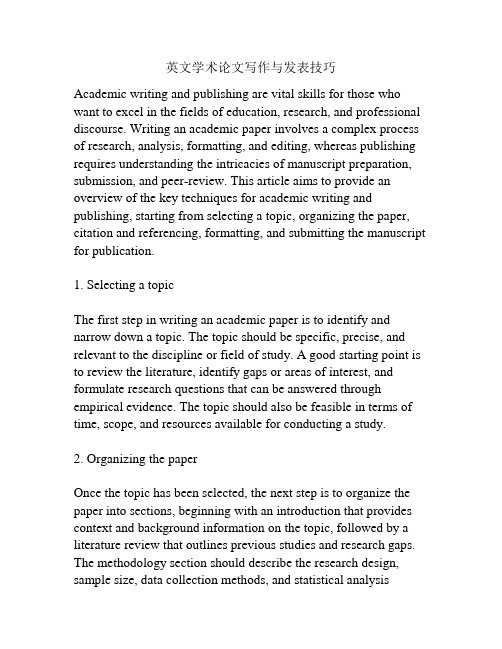
英文学术论文写作与发表技巧Academic writing and publishing are vital skills for those who want to excel in the fields of education, research, and professional discourse. Writing an academic paper involves a complex process of research, analysis, formatting, and editing, whereas publishing requires understanding the intricacies of manuscript preparation, submission, and peer-review. This article aims to provide an overview of the key techniques for academic writing and publishing, starting from selecting a topic, organizing the paper, citation and referencing, formatting, and submitting the manuscript for publication.1. Selecting a topicThe first step in writing an academic paper is to identify and narrow down a topic. The topic should be specific, precise, and relevant to the discipline or field of study. A good starting point is to review the literature, identify gaps or areas of interest, and formulate research questions that can be answered through empirical evidence. The topic should also be feasible in terms of time, scope, and resources available for conducting a study.2. Organizing the paperOnce the topic has been selected, the next step is to organize the paper into sections, beginning with an introduction that provides context and background information on the topic, followed by a literature review that outlines previous studies and research gaps. The methodology section should describe the research design, sample size, data collection methods, and statistical analysisprocedures.The results section should present the findings in an objective and clear manner, whereas the discussion section should interpret the results, discuss their implications, and suggest future research directions. Finally, the conclusion should summarize the key findings, restate the research questions, and draw overarching conclusions.3. Citation and referencingCitation and referencing are essential for academic writing because they provide evidence of the sources that have been used in the research, indicate the credibility of the study, and enable readers to locate and access the cited sources. The citation style should be consistent throughout the paper, and conform to the guidelines of the particular discipline or journal.4. FormattingFormatting involves the presentation of the paper in a professional and readable format, including the use of headings, fonts, margins, and spacing. The paper should also conform to the guidelines of the particular journal or publisher, including the preferred referencing style, manuscript length, and format. Attention to detail in formatting can increase the chances of acceptance for publication.5. Submitting the manuscript for publicationOnce the manuscript has been completed, it should be reviewed for grammatical errors, clarity, coherence, and overall quality before submitting it for publication. The submission process involves selecting an appropriate journal or publisher, following the guidelines for manuscript preparation, and submitting the paper online or through email. The review process involves evaluation by the editorial board or peer-reviewers, who provide feedback on the quality, relevance, and contribution of the study. Based on the feedback, authors can revise and resubmit the manuscript, or withdraw it and submit it to another journal or publisher.In conclusion, academic writing and publishing require a systematic and disciplined approach that involves selecting a suitable topic, organizing the paper, citing and referencing sources, formatting, and submitting it for publication. With practice, patience, and attention to detail, authors can improve their writing and publishing skills, and contribute to the advancement of knowledge in their respective fields.6. Tips for effective academic writing- Start with a clear and concise thesis statement that summarizes the main argument or research question, and guides the structure of the paper.- Use plain language and avoid technical jargon, unless it is necessary for clarity and precision.- Write in an objective and impersonal tone, avoiding personal opinions or emotions that may bias the interpretation of the data. - Use active voice and vary sentence structures to maintain reader engagement and clarity.- Follow the guidelines of the particular discipline or journal forcitation and referencing, which may include using footnotes, endnotes, or in-text citations.- Revise and proofread the paper multiple times, checking for grammar, spelling, punctuation, and formatting errors.- Seek feedback from colleagues, mentors, or writing tutors who can provide constructive criticism and suggestions for improvement.7. Tips for publishing academic papers- Select a journal or publisher that is reputable, relevant to the topic, and aligned with the research goals and scope.- Follow the guidelines for manuscript preparation and submission, which may include instructions for formatting, word count, file format, cover letter, and author declaration.- Choose appropriate keywords, abstract, and title that capture the essence of the study and attract readers' attention.- Engage in peer-review, which involves evaluating other scholars' papers and providing constructive feedback that can improve the quality and relevance of the research.- Stay up-to-date with the latest trends, debates, and theoretical frameworks in the field, by attending conferences, reading journals, and networking with peers.- Take advantage of social media, blogs, and online platforms to disseminate the findings and insights of the research to wider audiences, including policymakers, practitioners, and the general public.8. Challenges and opportunities in academic writing and publishingAcademic writing and publishing can be a rewarding but also challenging endeavour, as it requires dedication, perseverance, and continuous learning. Some of the challenges that scholars face include:- Time management, as writing and publishing can be time-consuming and require balancing multiple tasks and priorities.- Rejection and criticism, as not all papers get accepted for publication, and the feedback from reviewers can be rigorous and demanding.- Ethical considerations, such as plagiarism, data fabrication, and conflicts of interest, which can undermine the credibility and integrity of the research and authorship.However, there are also opportunities for growth, innovation, and impact in academic writing and publishing, such as:- Collaboration and teamwork, as scholars can benefit from exchanging ideas, collaborating on research projects, and co-authoring papers that showcase diverse perspectives and expertise. - Interdisciplinary and cross-cutting approaches, as academic writing and publishing can bridge different fields, methods, and theories, and contribute to solving complex and pressing social, economic, and environmental issues.- Open access and public engagement, as academic writing and publishing can involve making research findings and insights available to wider audiences, including policymakers, practitioners, and citizens, who can use them to inform their decisions and actions.In conclusion, academic writing and publishing are essential skills for scholars who aim to contribute to the advancement of knowledge in their fields, and communicate their ideas and insights to wider audiences. By following the key techniques and tips outlined in this article, scholars can improve their writing and publishing skills, overcome the challenges, and seize the opportunities of academic scholarship.。
四级英语作文时空类词汇
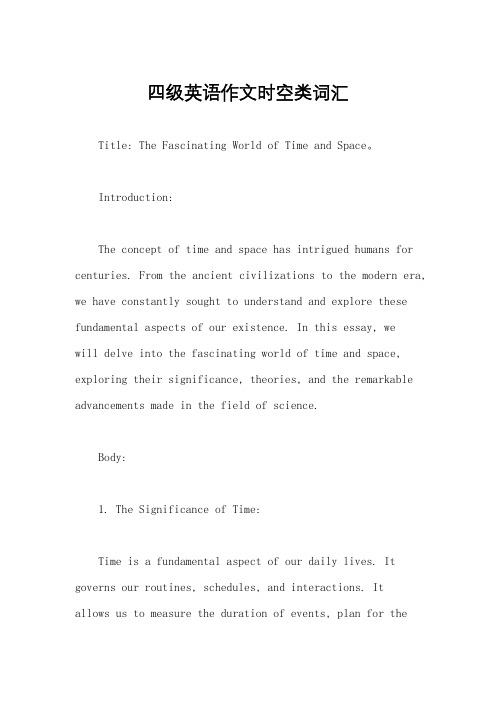
四级英语作文时空类词汇Title: The Fascinating World of Time and Space。
Introduction:The concept of time and space has intrigued humans for centuries. From the ancient civilizations to the modern era, we have constantly sought to understand and explore these fundamental aspects of our existence. In this essay, wewill delve into the fascinating world of time and space, exploring their significance, theories, and the remarkable advancements made in the field of science.Body:1. The Significance of Time:Time is a fundamental aspect of our daily lives. It governs our routines, schedules, and interactions. Itallows us to measure the duration of events, plan for thefuture, and reflect on the past. Time is a preciousresource that cannot be replenished once lost, making it essential to manage it effectively.2. The Concept of Space:Space, on the other hand, refers to the vast expansethat surrounds us. It is not only the physical areaoccupied by objects but also the dimension in which events occur. The exploration of space has been a constant endeavor of humanity, leading to remarkable discoveries and expanding our understanding of the universe.3. Theories on Time and Space:a. Relativity Theory:Albert Einstein's theory of relativity revolutionized our understanding of time and space. The theory proposesthat time and space are not separate entities but are interconnected in what is known as the fabric of space-time. It also introduced the concept of time dilation, where timecan appear to pass slower or faster depending on the relative motion of observers.b. Big Bang Theory:The Big Bang theory suggests that the universe originated from a singular point, expanding rapidly and giving rise to the cosmos as we know it. This theory provides insights into the birth and evolution of space and time, offering a glimpse into the origins of our universe.4. Time Travel:The concept of time travel has captured the imagination of many, inspiring countless works of fiction. While time travel remains purely speculative, it has been a subject of scientific inquiry. Theories such as wormholes and the concept of time loops have been proposed, but the practical realization of time travel remains elusive.5. Space Exploration:Humanity's quest to explore space has led tosignificant advancements in technology and scientific knowledge. From the first manned moon landing to the ongoing exploration of Mars, space missions have expanded our understanding of the universe and opened uppossibilities for future colonization and interplanetary travel.6. The Multiverse Theory:The multiverse theory posits the existence of multiple universes, each with its own set of physical laws and dimensions. This theory challenges our conventional understanding of space and time, suggesting that our universe may be just one of many.7. Time and Space in Literature and Art:Time and space have long been themes explored in literature and art. From H.G. Wells' "The Time Machine" to Salvador Dali's surreal paintings, artists and writers have used these concepts to provoke thought, challengeperceptions, and explore the human experience.Conclusion:The exploration of time and space has captivated the human mind for centuries. As we continue to unravel the mysteries of the universe, our understanding of these concepts evolves. Time and space remain enigmatic, yet their significance in shaping our existence cannot be denied. From scientific theories to artistic interpretations, the fascination with time and space continues to drive human curiosity, propelling us towards new frontiers of knowledge and understanding.。
可重复黏贴的英语作文
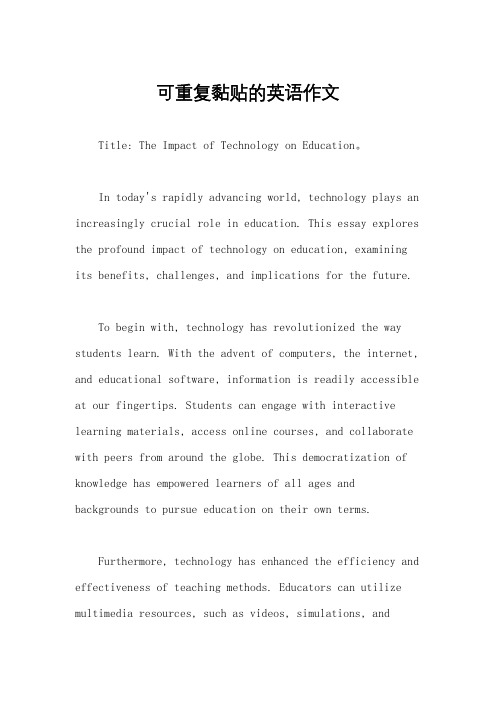
可重复黏贴的英语作文Title: The Impact of Technology on Education。
In today's rapidly advancing world, technology plays an increasingly crucial role in education. This essay explores the profound impact of technology on education, examining its benefits, challenges, and implications for the future.To begin with, technology has revolutionized the way students learn. With the advent of computers, the internet, and educational software, information is readily accessible at our fingertips. Students can engage with interactive learning materials, access online courses, and collaborate with peers from around the globe. This democratization of knowledge has empowered learners of all ages and backgrounds to pursue education on their own terms.Furthermore, technology has enhanced the efficiency and effectiveness of teaching methods. Educators can utilize multimedia resources, such as videos, simulations, andvirtual reality, to make lessons more engaging and immersive. Adaptive learning platforms can personalize instruction based on each student's strengths and weaknesses, catering to individual learning styles and preferences. Additionally, online assessment tools enable teachers to monitor student progress in real-time and provide timely feedback for improvement.Moreover, technology has expanded access to education, breaking down barriers of distance and affordability. Online learning platforms offer courses from top universities and institutions worldwide, allowing students to pursue higher education regardless of their geographic location. Furthermore, digital textbooks and open educational resources provide cost-effective alternatives to traditional printed materials, making education more accessible to economically disadvantaged populations.However, alongside these benefits, technology also presents challenges and concerns. One major issue is the digital divide, whereby disparities in access to technology exacerbate inequalities in education. Students from low-income or rural areas may lack reliable internet connectivity or access to modern devices, placing them at a disadvantage compared to their more privileged peers. Bridging this digital divide requires concerted efforts from policymakers, educators, and technology companies to ensure equitable access to educational resources for all students.Another challenge is the potential for technology to distract students and detract from their learning experience. The prevalence of smartphones, social media, and online entertainment can tempt students to disengage from academic pursuits and prioritize instant gratification over long-term goals. Moreover, concerns have been raised about the impact of excessive screen time on students' mental health and well-being, highlighting the need for balance and moderation in the use of technology in education.Looking ahead, the future of education will undoubtedly be shaped by continued advancements in technology. Emerging technologies such as artificial intelligence, augmentedreality, and blockchain have the potential to further transform teaching and learning in profound ways. However,it is essential to approach these developments thoughtfully and ethically, considering their implications for privacy, equity, and human connection in education.In conclusion, technology has had a transformative impact on education, offering unprecedented opportunitiesfor learning, teaching, and collaboration. While it has brought about numerous benefits, it also poses challenges that must be addressed to ensure that all students can reap the rewards of a technology-enhanced education. By harnessing the power of technology responsibly and inclusively, we can create a future where education is accessible, engaging, and empowering for learners worldwide.。
时间顺序写的英语作文技巧
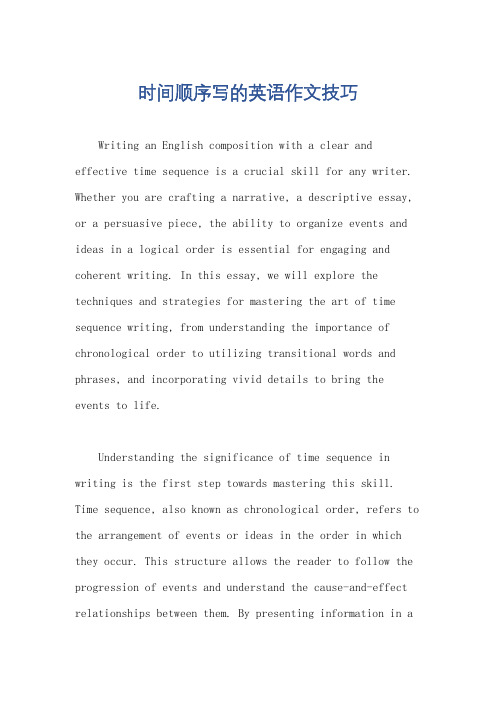
时间顺序写的英语作文技巧Writing an English composition with a clear and effective time sequence is a crucial skill for any writer. Whether you are crafting a narrative, a descriptive essay, or a persuasive piece, the ability to organize events and ideas in a logical order is essential for engaging and coherent writing. In this essay, we will explore the techniques and strategies for mastering the art of time sequence writing, from understanding the importance of chronological order to utilizing transitional words and phrases, and incorporating vivid details to bring the events to life.Understanding the significance of time sequence in writing is the first step towards mastering this skill. Time sequence, also known as chronological order, refers to the arrangement of events or ideas in the order in which they occur. This structure allows the reader to follow the progression of events and understand the cause-and-effect relationships between them. By presenting information in alogical sequence, writers can effectively convey their message and engage their audience. Whether you are recounting a personal experience, analyzing a historical event, or presenting a step-by-step process, employing a clear time sequence is essential for clarity and coherence.One of the most effective techniques for establishing a time sequence in writing is the use of transitional words and phrases. These words and phrases serve as signpoststhat guide the reader through the progression of events. Words such as "first," "next," "then," "afterward," and "finally" signal a shift in time and help to establish a clear timeline. Similarly, phrases like "in the beginning," "as time went on," and "in the end" provide context and continuity to the narrative. By strategically incorporating these transitional elements, writers can create a seamless and cohesive time sequence that enhances the flow of their writing.In addition to utilizing transitional words and phrases, incorporating vivid details and sensory imagery can bring a time sequence to life for the reader. Descriptive languagethat appeals to the senses – sight, sound, touch, taste, and smell – can transport the reader into the moment and create a more immersive experience. By painting a vivid picture of the setting, characters, and actions, writers can evoke emotions and capture the reader's attention. Whether you are describing a bustling city street, a serene natural landscape, or a tense confrontation, the inclusion of sensory details can enrich the time sequence and make the narrative more compelling.Furthermore, when crafting a time sequence in writing, it is important to consider the pacing of the narrative. The pacing refers to the rhythm and tempo at which events unfold in the story. By varying the pace, writers can create tension, build suspense, and maintain the reader's interest. For example, slowing down the pace during a pivotal moment can heighten the drama and draw the reader in, while speeding up the pace during a series of action-packed events can create a sense of urgency and excitement. By being mindful of pacing, writers can effectively control the ebb and flow of the narrative, ensuring that the time sequence is engaging and dynamic.Another aspect to consider when writing a time sequence is the use of flashback and foreshadowing. Flashbacks are a literary device that allows writers to insert scenes from the past into the current narrative, providing context and depth to the story. By seamlessly integrating flashbacks into the time sequence, writers can reveal important background information, develop characters, and create dramatic irony. Similarly, foreshadowing involves hinting at future events or outcomes, building anticipation and suspense for the reader. By strategically incorporating these literary devices, writers can enrich the time sequence and add complexity to their storytelling.In conclusion, mastering the art of time sequence writing is essential for creating engaging and coherent compositions. By understanding the significance of chronological order, utilizing transitional words and phrases, incorporating vivid details, considering pacing, and employing literary devices such as flashback and foreshadowing, writers can craft compelling narratives that captivate and resonate with their audience. Whether you arerecounting a personal experience, analyzing a historical event, or presenting a step-by-step process, the ability to effectively organize events and ideas in a logical order is a valuable skill that can elevate your writing to new heights.。
英文诗歌投稿技巧作文
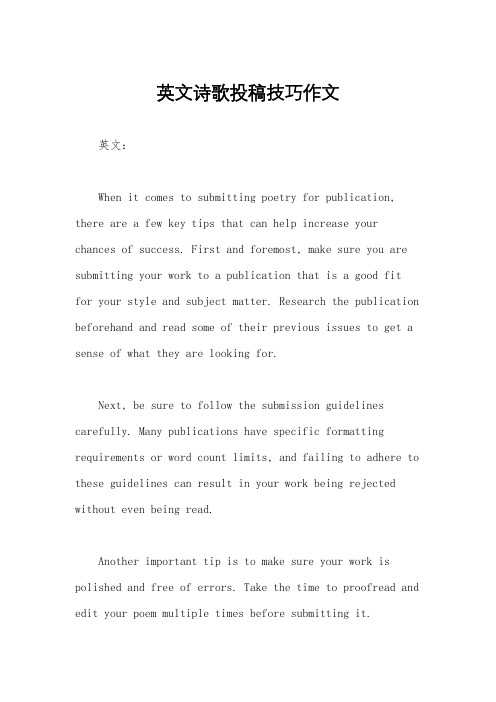
英文诗歌投稿技巧作文英文:When it comes to submitting poetry for publication, there are a few key tips that can help increase your chances of success. First and foremost, make sure you are submitting your work to a publication that is a good fitfor your style and subject matter. Research the publication beforehand and read some of their previous issues to get a sense of what they are looking for.Next, be sure to follow the submission guidelines carefully. Many publications have specific formatting requirements or word count limits, and failing to adhere to these guidelines can result in your work being rejected without even being read.Another important tip is to make sure your work is polished and free of errors. Take the time to proofread and edit your poem multiple times before submitting it.Consider having someone else read it as well to get a fresh perspective and catch any mistakes you may have missed.Finally, don't get discouraged if your work is rejected. Rejection is a natural part of the submission process, andit doesn't necessarily mean your work isn't good enough. Keep writing and submitting, and eventually you will find the right publication for your work.中文:在投稿诗歌时,有几个关键的技巧可以增加成功的机会。
英语作文时间顺序词高级
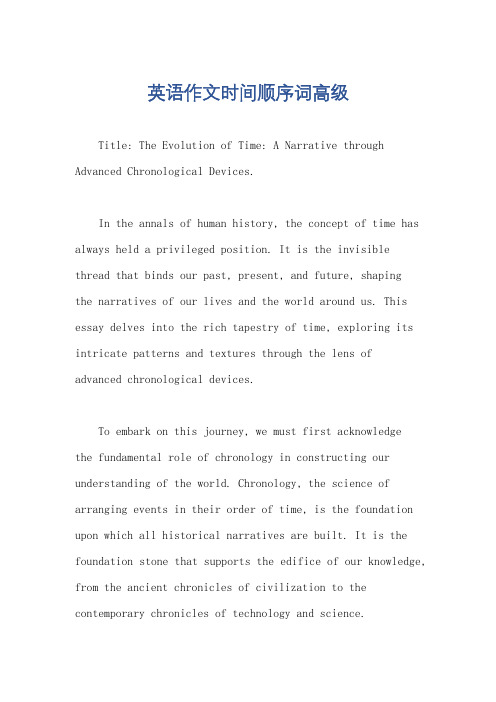
英语作文时间顺序词高级Title: The Evolution of Time: A Narrative through Advanced Chronological Devices.In the annals of human history, the concept of time has always held a privileged position. It is the invisible thread that binds our past, present, and future, shapingthe narratives of our lives and the world around us. This essay delves into the rich tapestry of time, exploring its intricate patterns and textures through the lens of advanced chronological devices.To embark on this journey, we must first acknowledgethe fundamental role of chronology in constructing our understanding of the world. Chronology, the science of arranging events in their order of time, is the foundation upon which all historical narratives are built. It is the foundation stone that supports the edifice of our knowledge, from the ancient chronicles of civilization to the contemporary chronicles of technology and science.As we delve deeper into the annals of time, weencounter a range of chronological devices that haveenabled us to measure, represent, and understand time more precisely. One such device is the calendar, a system that has evolved over the centuries to reflect the complexitiesof our understanding of the cosmos and its cycles. The ancient Egyptians, for instance, developed a solar calendar based on the observation of the sun's movement, while the Mayans created a sophisticated calendar that accurately predicted eclipses and the length of the solar year.The development of the clock, another crucial chronological device, marked a significant milestone in our ability to measure time. The earliest mechanical clocks, dating back to the 14th century, were bulky and inaccurate, but they marked the beginning of a revolution in timekeeping. Over time, clocks became smaller, more precise, and more accessible, enabling individuals and communitiesto synchronize their activities and coordinate their efforts.The advent of the modern era brought furtherrevolutions in timekeeping. The development of the atomic clock in the 20th century marked a quantum leap in accuracy, as it measured time based on the oscillations of atoms, rather than the rotation of the earth or the movement ofthe sun. This technological marvel has enabled us to synchronize our global communication systems and GPS networks with unprecedented precision.Beyond the realm of physical timekeeping devices, we also encounter abstract chronological frameworks that help us understand and narrate the flow of time. The concept of the life cycle, for instance, provides a framework for understanding the passage of time in the life of an individual or a community. It charts the journey from birth to death, marking key milestones and transitions along the way. Similarly, the concept of historical periods helps us categorize and compare different eras based on shared cultural, political, and technological characteristics.In conclusion, the journey through the annals of time has revealed the rich tapestry of chronological devicesthat have shaped our understanding and experience of time. From the ancient chronicles of civilization to the contemporary chronicles of technology and science, these devices have enabled us to measure, represent, and understand time with increasing precision. They have been the silent witnesses to the rise and fall of empires, the discovery of new continents, and the发明of groundbreaking technologies. As we continue to explore the mysteries of time, these devices will continue to play a pivotal role in shaping our narratives and guiding our decisions.。
英语二大作文写作时间
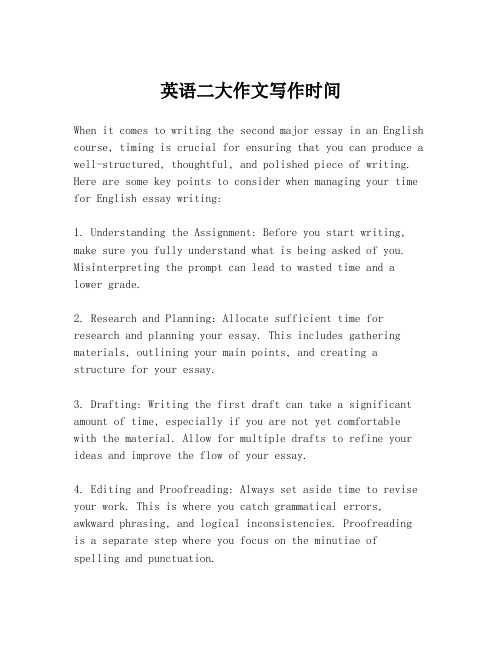
英语二大作文写作时间When it comes to writing the second major essay in an English course, timing is crucial for ensuring that you can produce a well-structured, thoughtful, and polished piece of writing. Here are some key points to consider when managing your time for English essay writing:1. Understanding the Assignment: Before you start writing, make sure you fully understand what is being asked of you. Misinterpreting the prompt can lead to wasted time and a lower grade.2. Research and Planning: Allocate sufficient time for research and planning your essay. This includes gathering materials, outlining your main points, and creating a structure for your essay.3. Drafting: Writing the first draft can take a significant amount of time, especially if you are not yet comfortable with the material. Allow for multiple drafts to refine your ideas and improve the flow of your essay.4. Editing and Proofreading: Always set aside time to revise your work. This is where you catch grammatical errors, awkward phrasing, and logical inconsistencies. Proofreading is a separate step where you focus on the minutiae ofspelling and punctuation.5. Peer Review: If possible, have someone else read your essay before you submit it. A fresh set of eyes can often catch mistakes you might have missed.6. Contingencies: Build in buffer time for unexpected delays or the need for additional research. It's better to have extra time and not need it than to be rushed at the last minute.7. Writing Schedule: Create a writing schedule that fits your personal workflow. Some people work better in the morning, while others are more productive late at night.8. Breaks: Remember to take regular breaks to avoid burnout. Short walks or relaxation can help clear your mind and improve focus when you return to your work.9. Deadline Awareness: Always be aware of the submission deadline and work backwards from there to set your own personal deadlines for each stage of the writing process.10. Avoid Procrastination: It's easy to put off writing until the last minute, but this can lead to stress and a lower quality essay. Start early and maintain a steady pace.By managing your time effectively, you can ensure that you not only meet the deadline but also produce an essay that you can be proud of. Remember, good writing often takes time, so plan accordingly.。
英美报刊选读(辅修) 范数 -回复
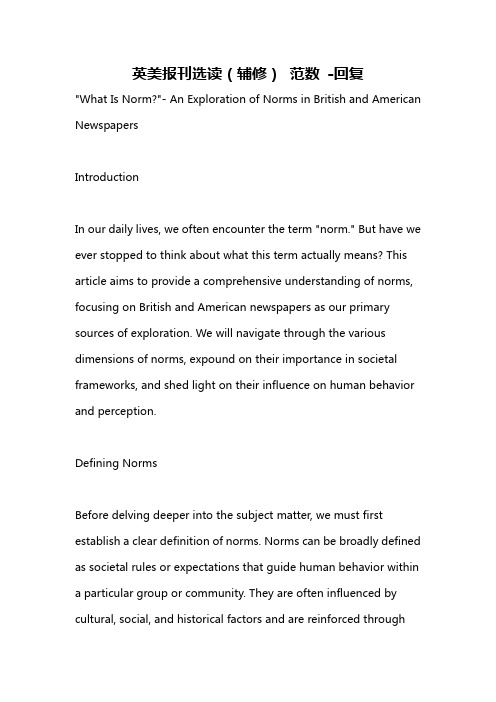
英美报刊选读(辅修)范数-回复"What Is Norm?"- An Exploration of Norms in British and American NewspapersIntroductionIn our daily lives, we often encounter the term "norm." But have we ever stopped to think about what this term actually means? This article aims to provide a comprehensive understanding of norms, focusing on British and American newspapers as our primary sources of exploration. We will navigate through the various dimensions of norms, expound on their importance in societal frameworks, and shed light on their influence on human behavior and perception.Defining NormsBefore delving deeper into the subject matter, we must first establish a clear definition of norms. Norms can be broadly defined as societal rules or expectations that guide human behavior within a particular group or community. They are often influenced by cultural, social, and historical factors and are reinforced throughmechanisms such as laws, customs, and traditions.Norm DevelopmentNorms are not static; they undergo a continuous process of development. British and American newspapers provide a valuable platform for observing the evolution of norms over time. These publications act as a reflection of society and hold the power to shape and reinforce norms through the dissemination of information and opinions.Norms as Social RegulatorsNorms serve as social regulators by setting guidelines for acceptable behavior within a societal framework. British and American newspapers play a crucial role in promoting and reinforcing these norms by reporting on societal events and phenomena. Whether it is reporting on legal and political issues or social and cultural trends, newspapers act as powerful agents in shaping public opinion and influencing the adherence to societal norms.Norms as a Measure of DevianceAnother aspect of norms is their ability to define what is considered deviant behavior within a community. Through their reporting and journalistic investigations, British and American newspapers highlight cases that deviate from established norms. By publicizing these cases, newspapers not only create awareness but also contribute to the reaffirmation of societal boundaries and expectations.Norms as Cultural IdentitiesNorms also define the cultural identities of communities. British and American newspapers capture these cultural nuances by reporting on events, traditions, and practices unique to their respective societies. By consistently showcasing cultural norms, newspapers reinforce the distinct identities of their readers and promote a sense of belonging and pride within these communities.Norms in Language and CommunicationLanguage plays a crucial role in expressing and understandingnorms. British and American newspapers provide an excellent platform for studying the linguistic aspects of norms. From the choice of words to the structure of sentences and the use of rhetoric, newspapers shape the language of norms and effectively communicate societal expectations to their readers.Challenging Norms: The Role of NewspapersAlthough norms are essential for maintaining social order and unity, they are not immune to criticism and revision. British and American newspapers often challenge established norms through investigative journalism and critical analysis. They provide a platform for dissenting voices and facilitate public discourse on controversial issues, pushing the boundaries of accepted norms and paving the way for social progress.ConclusionBritish and American newspapers serve as valuable resources for understanding and analyzing norms. From their role in shaping social values to their impact on public opinion, newspapers providea comprehensive view of how norms evolve, influence behavior, and shape cultural identities. By exploring these dimensions, we can gain a better understanding of the complex web of norms that govern our societies and, perhaps, challenge them for the betterment of humanity.。
考研英语作文能不能写时间
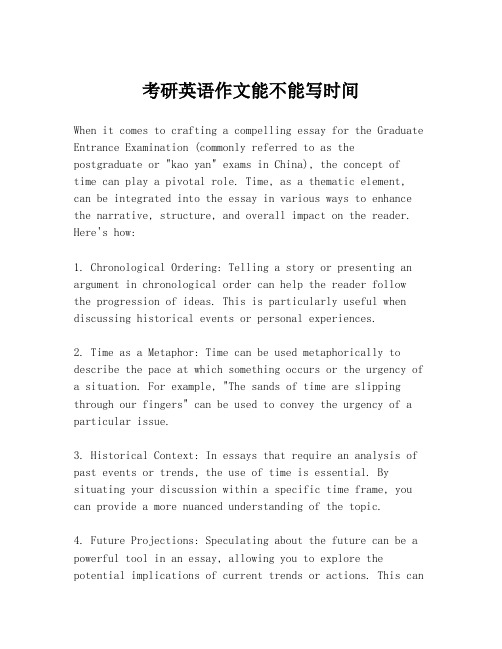
考研英语作文能不能写时间When it comes to crafting a compelling essay for the Graduate Entrance Examination (commonly referred to as the postgraduate or "kao yan" exams in China), the concept of time can play a pivotal role. Time, as a thematic element, can be integrated into the essay in various ways to enhance the narrative, structure, and overall impact on the reader. Here's how:1. Chronological Ordering: Telling a story or presenting an argument in chronological order can help the reader follow the progression of ideas. This is particularly useful when discussing historical events or personal experiences.2. Time as a Metaphor: Time can be used metaphorically to describe the pace at which something occurs or the urgency of a situation. For example, "The sands of time are slipping through our fingers" can be used to convey the urgency of a particular issue.3. Historical Context: In essays that require an analysis of past events or trends, the use of time is essential. By situating your discussion within a specific time frame, you can provide a more nuanced understanding of the topic.4. Future Projections: Speculating about the future can be a powerful tool in an essay, allowing you to explore the potential implications of current trends or actions. This canbe done through hypothetical scenarios or by extrapolating from existing data.5. Time Management: Discussing the importance of time management in the context of a student's journey towards higher education can be a unique angle. It can reflect on the personal discipline and planning required to succeed in rigorous academic programs.6. Cultural Perceptions of Time: Time is perceiveddifferently across cultures. This can be an interesting point of discussion, especially when comparing Eastern and Western perspectives on the value of time and its role in education and personal development.7. The Time Factor in Research: In academic essays, discussing the time constraints of research can highlight the challenges faced by researchers and the importance ofefficient methodologies.8. Timeless Wisdom: Referencing timeless wisdom or quotesthat have stood the test of time can add depth to your essay, showing that your argument or viewpoint is well-grounded in history.9. The Passage of Time: Reflecting on how the passage of time affects societal norms, technology, or personal growth can provide a reflective and insightful angle to your essay.10. Time-Bound Achievements: Discussing achievements that are time-bound, such as meeting a research deadline or completinga degree within a set timeframe, can demonstrate the importance of setting and meeting goals.In conclusion, time is not just a backdrop in an essay; it is a multifaceted tool that can be used to structure, enrich,and deepen the content of your writing. When used effectively, it can help you craft a more engaging and persuasive graduate entrance English essay.。
英美报刊选读(辅修) 纵模 -回复
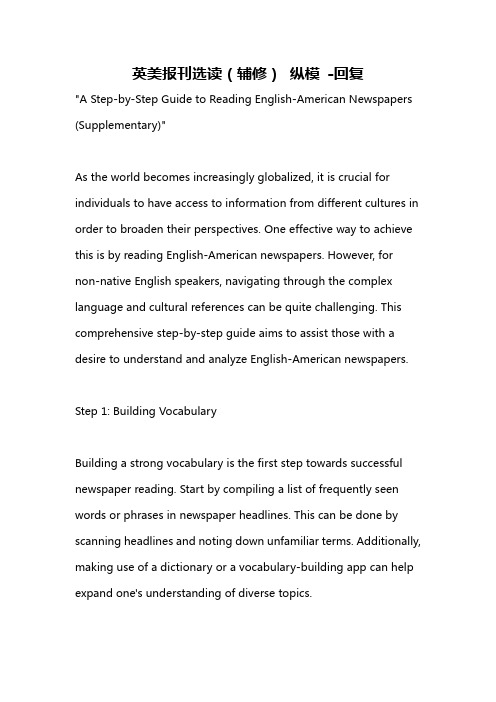
英美报刊选读(辅修)纵模-回复"A Step-by-Step Guide to Reading English-American Newspapers (Supplementary)"As the world becomes increasingly globalized, it is crucial for individuals to have access to information from different cultures in order to broaden their perspectives. One effective way to achieve this is by reading English-American newspapers. However, fornon-native English speakers, navigating through the complex language and cultural references can be quite challenging. This comprehensive step-by-step guide aims to assist those with a desire to understand and analyze English-American newspapers.Step 1: Building VocabularyBuilding a strong vocabulary is the first step towards successful newspaper reading. Start by compiling a list of frequently seen words or phrases in newspaper headlines. This can be done by scanning headlines and noting down unfamiliar terms. Additionally, making use of a dictionary or a vocabulary-building app can help expand one's understanding of diverse topics.Step 2: Understanding the StructureUnderstanding the structure of newspaper articles is essential for effective reading. Articles typically follow a particular format, including a headline, subheadings, lead paragraph, body paragraphs, and a conclusion. By identifying these sections, readers can quickly grasp the main points of an article and decide whether to read it in its entirety or skim through for relevant information.Step 3: Identifying Bias and ObjectivityRecognizing bias and objectivity in news reporting is vital for critical analysis. English-American newspapers often have different political affiliations, which can influence the way stories are covered. It is essential to examine the language used, the sources quoted, and the overall tone of the article to discern any potential biases. Comparing multiple sources on the same topic can help provide a well-rounded understanding.Step 4: Connecting Context and CultureUnderstanding the context and cultural references inEnglish-American newspapers is essential for comprehensive comprehension. Familiarity with socio-political events, historical figures, and popular culture references can greatly enrich the reading experience. Engaging with news articles that discuss significant events or figures and conducting additional research will enable readers to grasp the intended meanings behind such references.Step 5: Practicing Reading ComprehensionImproving reading comprehension skills is essential for fully understanding English-American newspapers. Engage in regular reading exercises tailored to the specific newspaper style. This can involve reading articles and then summarizing the main points, engaging in discussions about the articles, or answering comprehension questions. Gradually increasing the difficulty level of the articles will help enhance comprehension skills over time.Step 6: Expanding Knowledge through Opinion PiecesOpinion pieces offer a different perspective and allow readers to delve into in-depth analyses of contemporary issues. These piecesoften present arguments and counterarguments, helping readers develop critical thinking skills. Actively seeking out opinion pieces and engaging with different viewpoints will expand one's knowledge and understanding of complex issues.Step 7: Staying InformedStaying informed is an ongoing process that requires regular engagement with English-American newspapers. Make it a habit to read newspapers daily or on a regular basis. Subscribing to email newsletters or following reliable news sources on social media platforms can also provide a steady stream of information. Staying updated not only improves language skills but also facilitates an understanding of current events and international affairs.In conclusion, reading English-American newspapers provides an excellent opportunity to expand one's knowledge, language proficiency, and cultural understanding. By building vocabulary, understanding the structure, identifying bias, connecting context and culture, practicing reading comprehension, expanding knowledge through opinion pieces, and staying informed, readers can navigate through these newspapers successfully. Embrace thechallenge and embark on an enriching journey of English-American newspaper reading.。
英语活页本 -回复
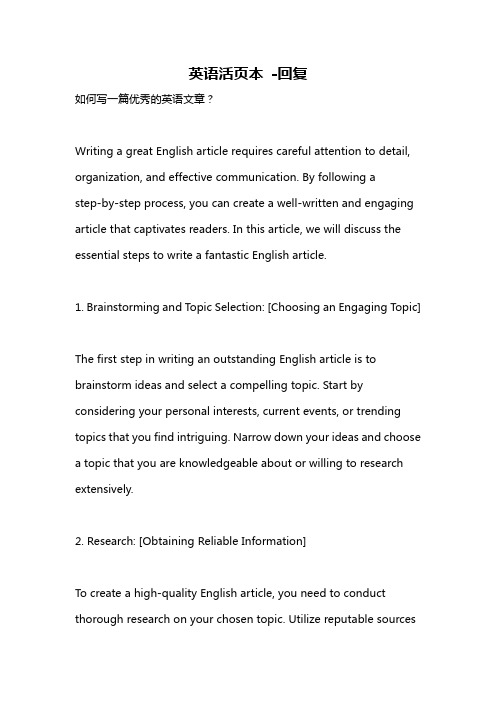
英语活页本-回复如何写一篇优秀的英语文章?Writing a great English article requires careful attention to detail, organization, and effective communication. By following astep-by-step process, you can create a well-written and engaging article that captivates readers. In this article, we will discuss the essential steps to write a fantastic English article.1. Brainstorming and Topic Selection: [Choosing an Engaging Topic]The first step in writing an outstanding English article is to brainstorm ideas and select a compelling topic. Start by considering your personal interests, current events, or trending topics that you find intriguing. Narrow down your ideas and choose a topic that you are knowledgeable about or willing to research extensively.2. Research: [Obtaining Reliable Information]To create a high-quality English article, you need to conduct thorough research on your chosen topic. Utilize reputable sourcessuch as books, scholarly articles, and authoritative websites to gather accurate and reliable information. Take detailed notes and make sure to cite your sources properly.3. Outline: [Structuring Your Article]Before diving into writing, create an outline to organize your thoughts and structure your article effectively. Determine the main points you want to address and arrange them logically in a coherent manner. A good outline will ensure that your article flows smoothly from one idea to another, making it easier for readers to follow.4. Introduction: [Engaging Your Readers]The introduction is the first impression your readers will have of your article. Start with a captivating hook or an intriguing question to grab their attention. Provide background information on the topic and present a clear and concise thesis statement that outlines the purpose of your article.5. Body Paragraphs: [Supporting Your Thesis]The body paragraphs should support your thesis statement with relevant evidence, examples, and arguments. Each paragraph should focus on one main idea and provide sufficient supporting details. Use clear and concise language, and ensure that each paragraph transitions smoothly to the next.6. Conclusion: [Summarizing Your Main Points]The conclusion brings your article to a close by summarizing the main points discussed in the body paragraphs. Restate your thesis statement and provide a final thought or call to action. Leave your readers with a lasting impression and a sense of closure.7. Revision and Editing: [Polishing Your Work]After completing the initial draft, it is crucial to revise and edit your article. Read through your work carefully, checking for grammar and spelling errors, sentence structure, and overall coherence. Look for areas where you can improve clarity or tighten your arguments. Consider seeking feedback from a peer or using online editing tools to ensure a polished and error-free final draft.8. Proofreading: [Ensuring Accuracy]Proofreading is a vital step to catch any remaining errors or inconsistencies. Pay attention to punctuation, spelling, and grammar mistakes. Use online grammar checkers or ask someone proficient in English to proofread your article before submission.9. Formatting and Citations: [Following Style Guidelines]Follow the appropriate style guidelines, such as APA, MLA, or Chicago, for formatting and citations. Ensure that your citations are accurate and properly formatted to give credit to the original sources you used in your research.10. Final Review: [Double-Checking Your Work]Before finalizing your English article, take one last thorough review. Read through your entire article from start to finish, ensuring that it flows smoothly and all the points are well-supported. Make any necessary revisions or corrections.In conclusion, writing an exceptional English article requires careful planning, research, organization, and meticulous revision. By following the step-by-step process outlined above, you can create a well-crafted article that effectively communicates your ideas to readers. Practice regularly, and with time, your writing skills will continue to improve, allowing you to produce outstanding work consistently.。
- 1、下载文档前请自行甄别文档内容的完整性,平台不提供额外的编辑、内容补充、找答案等附加服务。
- 2、"仅部分预览"的文档,不可在线预览部分如存在完整性等问题,可反馈申请退款(可完整预览的文档不适用该条件!)。
- 3、如文档侵犯您的权益,请联系客服反馈,我们会尽快为您处理(人工客服工作时间:9:00-18:30)。
義守大學燕巢宿舍區簡介
燕巢分部校舍
一、宿舍大門入口
二、大廳服務檯
三、男生入口
四、女生入口
五、一樓洗衣房的洗手檯
六、洗衣房之洗衣機、販賣機
七、書桌、櫃及衣櫃(整體)
八、書桌、櫃及衣櫃(個人一、每層一間交誼廳
十二、交誼廳內擺設
燕巢分部宿舍區概述
(一)本宿舍區分配醫學院各系同學住宿。 (二)住宿費用:宿舍費用以學期為單位收 費,宿舍計費包含寒假,不包含暑假。 (三)兩人套房,提供床舖、書桌櫃、衣櫃、 冷氣空調、網路等硬體設施。
燕巢分部宿舍區概述
(四)床舖:長約195cm、寬約102cm,請 自備枕頭、棉被。 (五)本區宿舍每層樓有一交誼廳,提供有 線電視收視。 (六)本宿舍大樓地下室,設置運動休閒 設施。 (七)餐廳、教室、圖書館、電腦教室等 設備皆設置於宿舍前方之『教學大樓』 內。
